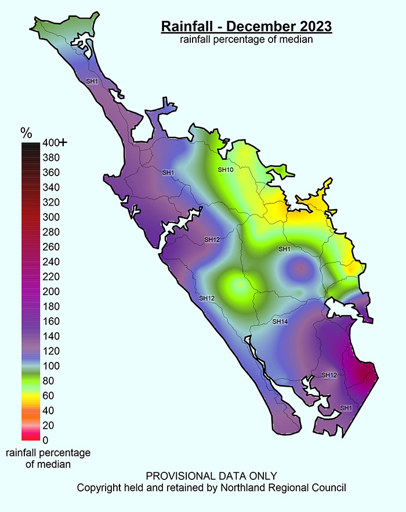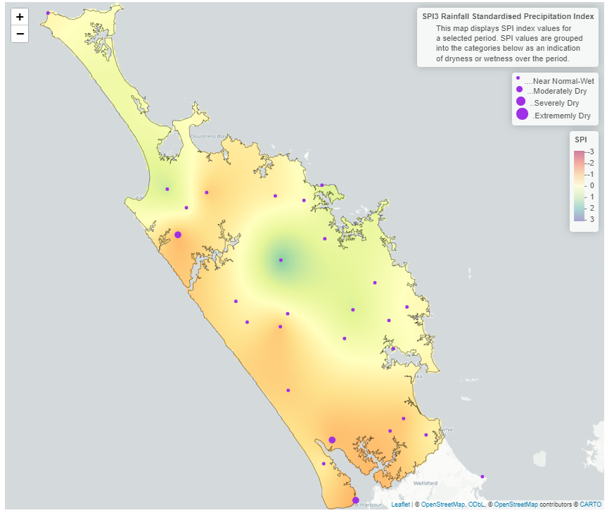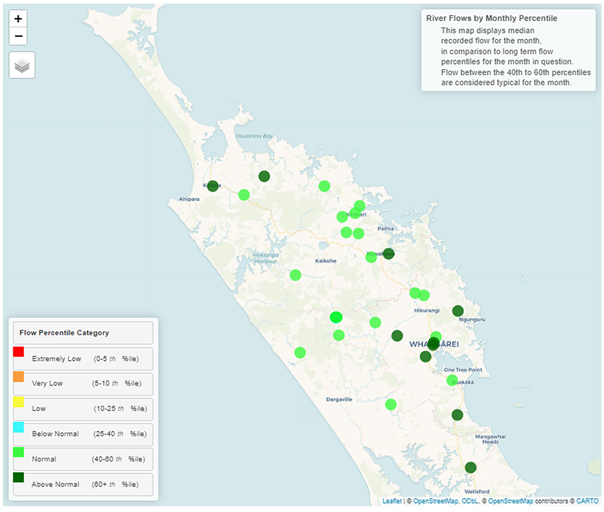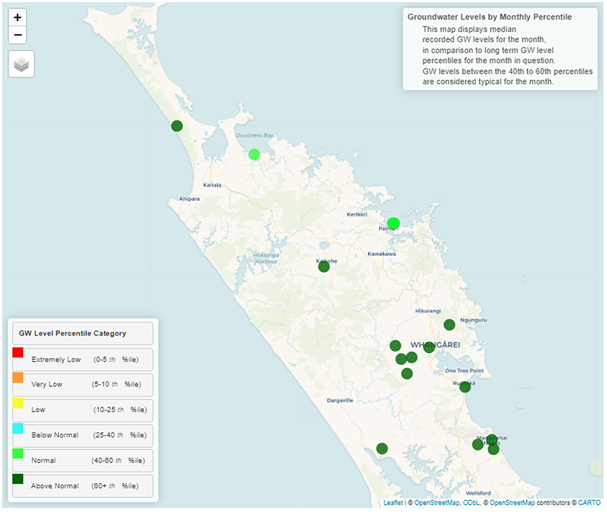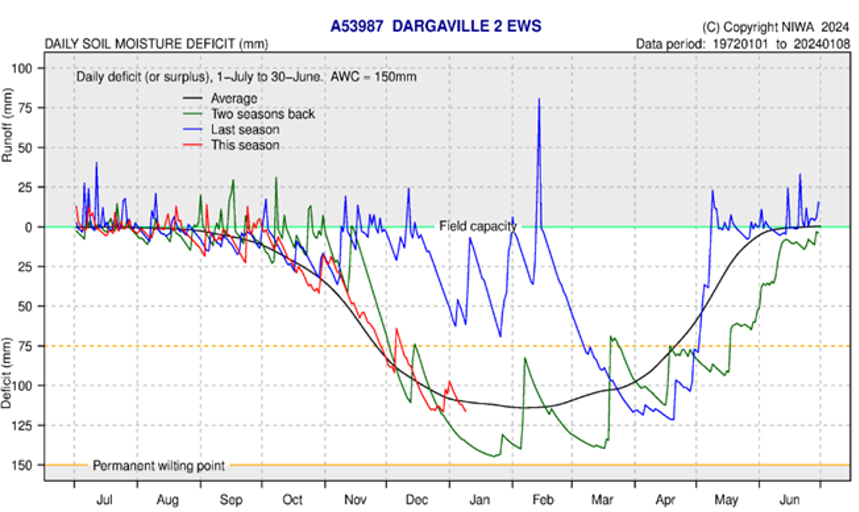December 2023 climate report
15 Jan 2024, 9:00 AM
Summary
- El Niño Southern Oscillation (ENSO) conditions are set to continue till March, however due to other factors, we are likely to have abnormal El Niño conditions for January, before possibly becoming dry in February and March.
- Temperatures are likely to be “Above Average”, with “Above Average” Humidity.
- Rainfall is likely to be “Near Average”.
- Rainfall in December was near the average for the region, and the SPI index shows between October – December the region is near normal to wet.
- River flows and groundwater levels in most catchments are “Above Normal” for December.
- Soil moisture is near average across the region for the start of January, there is a deficit of 50 -125 mm, some plant stress is likely to be occurring.
Climate Summary for December 2023
El Niño conditions continued through December, with the pressure variation in the Pacific (NINO3.4 Index) for December being +2.01°C, which is the fourth strongest event on record. However, weather conditions recorded through December did not follow the expected patterns for an El Niño event. This is because of three reasons:
- The Southern Oscillation Index was in the neutral range for December (-0.4), and the neutral side of El Niño for October and November (-0.6), reducing the driving force of El Niño conditions over New Zealand;
- Surface Sea temperatures across majority of the Pacific Ocean Basin are warmer than expected, causing a “full basin” event; and
- The Indian Ocean Dipole is strongly positive causing convective forcing in the New Zealand to be reduced allowing uncommon weather patterns to pass through New Zealand during December.
Climate Outlook for January – March 2024
El Niño has a 100% chance of persisting till March but is expected to begin weakening in February. The Madden-Julian Oscillation is currently active in the Indian Ocean but is expected to move across New Zealand into the Pacific during end of January, which could bring heavy rainfall to the North Island during the second half of the month, as well as significant humidity and heat waves.
In February and March the convective forcing in the central Pacific, which has been active throughout 2023, is expected to ease. This should mean New Zealand is less exposed to northerly low-pressure systems, bringing drier conditions.
In Northland we can expect Above Average temperatures for January – March, “Near Average” rainfall, and either “Near Average” or “Below Average” soil moisture and river flows. The classic El Niño is likely to not occur, as many factors are driving the weather for the 2023 -2024 season, however the NZ drought dashboard takes into account all the climate drivers available and provides a 35-day outlook, with daily updates:
Drought forecasting dashboard on NIWA's website: niwa.co.nz
For more details, please refer to NIWA’s seasonal climate outlook for January - March 2024:
NIWA Temperature, Rainfall, Soil Moisture and River Flows probabilities for the period of January to March 2024
(Expressed as % likelihood for either Above Average, Near Average or Below Average conditions).
| Temperature | Rainfall | Soil moisture | River flows | |
| Above average | 60• | 30 | 20 | 20 |
| Near average | 30 | 45• | 40• | 40• |
| Below average | 10 | 25 | 40• | 40• |
Rainfall
The December rainfall in Northland was close to expected, with an average of 115.7 mm, 109%, for the month. Majority of the rainfall fell in the first week of the month when a frontal system passed through, then was topped off with scattered thunderstorms at the end of the month.
The Far North, Hokianga, and Mangawhai areas were the wettest, with Hakaru at Tara recorded 266mm, 263% of expected. The Bay of Islands and eastern areas were far drier with the lowest recorded rainfall at Ōpua with 52.5 mm recorded, 40% of expected.
Rainfall (% of Median) for December 2023 across Northland with a range of 40% to 263%
Standardised Precipitation index (SPI)
The Standardised Precipitation Index (SPI) on a three-month scale shows that all of Northland has been “near normal or wet”, The wettest areas in the region are spread from Kaikohe down the east coast, and the northern reaches, with positive SPI values (greens to blues), while the western area of Northland is still near normal but moving into negative SPI values.
3-Month SPI (Standardised Precipitation Index) Map for October – December 2023
River flow
River flows in Northland during December were either “Normal” or “Above Normal” for the first part of the month. “Above Normal” flows were recorded in catchments where higher than average rainfall was recorded.
Monthly percentile River Flows for December 2023
Groundwater
Water levels in most key aquifers in Northland are currently recording “above normal” for December, other than at Taipa where levels are currently at expected levels for December, while Russell is currently lower than normal.
| Aquifer | Status | Percentile |
| Aupōuri | Above normal | 60th+ |
| Taipā | Normal | 40th - 60th |
| Russell | Low | 10th - 25th |
| Kaikohe | Above normal | 60th+ |
| Poroti | Above normal | 60th+ |
| Whangārei | Above normal | 60th+ |
| Mangawhai | Above normal | 60th+ |
| Marsden - Ruakākā | Above normal | 60th+ |
| Ruawai | Above normal | 60th+ |
Groundwater levels for December 2023
Soil Moisture
During December soil moisture for majority of the region was near average, with some plant stress occurring, however Warkworth was lower than average and experienced some significant deficit in available water.
Moving into the start of January, following the scattered rain across the region, all areas apart from Kerikeri have recovered with current moisture levels higher than average. The soil moisture deficit across the region is currently ranging from 50 mm – 125 mm.
Temporary wilting is noted at 75 mm, so some areas might be noticing some reduction in plant growth, and increased plant stress. The soil moisture deficit is calculated based on incoming daily rainfall (mm), outgoing daily potential evapotranspiration (mm), and a fixed available water capacity (the amount of water in the soil 'reservoir' that plants can use) of 150 mm” (NIWA).

